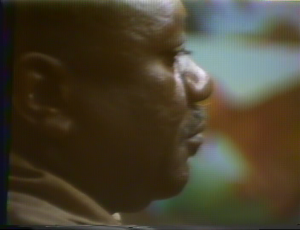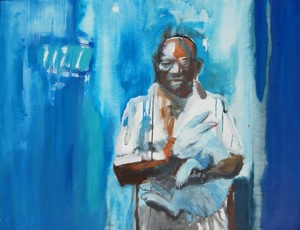This mini-doc was part of a series of mini-docs of thirteen artists — masters of Haitian painting and sculpture — who were included in the first major exhibit of Haitian Art in the U.S. at The Brooklyn Museum in 1978. Ute Stebich, the curator of this exhibit of painting, sculpture and papier mache objects, conducted the original interviews that are featured here. The artist videos were part of a video jukebox featured in the galleries where the work was displayed. Two other longer video documentaries were screened on monitors in the galleries — an introduction to Haitian Art and Ra-Ra, a Haitian festival.
The artists included in this video juke box were: Painters: Philome Obin, Rigaud Benoit, Salnave Philippe -Auguste, Jasmin Joseph, Gerard Valcin, Prefete Duffaut, Andre Pierre, Jacques -Enguerrand Gourgue, Bernard Sejourne, Max Gerbier, Celestin Faustin; and the sculptors: Georges Liautaud and Serge Jolimeau.
Jasmin Joseph — like most of the artists featured in this exhibit — came from humble origins. Joseph used the first money he made from his art to learn to read and write. Joseph began making art through carving terra-cotta sculptures that came to the attention of Jason Seeley, an American sculptor who partnered with Dewitt Peters – a watercolorist — to establish the Centre D’Art in Port-au-Prince. In th 40’s, 50’s and 60’s Peters nurtured and sold the works of Haiti’s indigenous and largely untrained talent. Joseph’s sculptures — Stations of the Cross – adorned the famous St Trinity Cathedral in downtown Port-au-Prince where the first generation of naif painters also created gigantic murals for the church walls.
That church and its contents were destroyed in the catastrophic earthquake in January, 2010. Joseph soon turned to painting himself and in 1978 when this video was made, his work, like the other first generation of master painters was coming to world recognition. He explains what he thinks is problematic about the term “primitive” which is often used to describe these indigenous, formally untrained, artists.



A wonderful documentary. I have owned a Haitian painting ever since the early 1970s and it was sold to me as a Jasmin Joseph at the time even though it is signed “P. Joseph” I am trying to authenticvate the work and would appreciate any lead to that effect. I can send a photo by email if needed. Thank you, E. Passantino
To E. Passantino: your painting is probably Pierre Joseph, one of the very wonderful naive artists who had a long career in Haiti. Please send the photo of your painting to galeriemonnin@galeriemonnin.com and we will be happy to authenticate it.
Cordially, Toni Monnin
We are fortunate to have several Haitian artworks which we love including one by Jasmin Joseph almost identical to one in “The Master Painters of Haiti” catalogue from the Meadow Brook Art Gallery at Oakland University entitled “Manifestation des Chats a Noel.” I would like to find out if this is from his pre-Christian era and how to determine its value today.
I too own a wonderful Jasmin Joseph painting entitled “Noa’s Arc” which depicts the island of Haiti as an arc and is populated with small jumping rabbits, a few human figures and simple houses on a green mountainous landscape. My father purchased the painting on a visit to Haiti in the fifties or early sixties, I believe. A few years ago Jonathan Demme, the film director, hosted an exhibit of his large collection of paintings by Joseph in New York City. I’m not interested in selling the painting at this time but would be happy to provide photo if there are organizations interested in knowing where Joseph’s paintings are.
Dear Phylis, Thank you for taking time to comment on this site. I am sure that some of the major galleries in P-au-P would appreciate knowing, but also there is a group that have formed to resurrect and re-build The Centre D’arte where Joseph was deeply attached. You can find them on the web. Good luck!
About five years ago i purchased a piece of art at all places, a yard sale ,in Palm Springs, Ca. until recently i never paid much attention to the signature or the artist. It is signed in the upper right hand corner J M Joseph.it is an oil painting on canvas of a sea scape scene , with fishermen on their boats in a wharf that could be somewhere in jaimacai i suppose. I would like to know more about the piece if possible but am unsure as to where to send pictures or who to ask. Sincerely, Ed Martinez
Hello, I have a Jasmine Joseph framed painting on masonite approx. 65″ x 24″ Titled “the Hearing”
It is a series of fantasy bears sitting around a similar Judge and scribe listening to another pleading his case. It is a delightful piece that I would be interested in donating to a public collection. How can I determine a value and a possible recipient ? Thanks. Mark
I admire Jasmin’s work and would love to have a piece of his in my home.
If anyone wanted to sell a painting, I would pay a fair price.
Thank you.
John Willis
Hello John Willis:
Have you tried contacting Monin gallery in Port-au-Prince? Gail
I have an original Jasmin Joseph painting for sale- pls email for details- djsykes@btconnect.com
Hi! Just found this wonderful site!! THANK YOU! My question might be far afield…but will try anyway…I recently lost in a fire an uninsured Haitian Voodoo painting (people surrounding, gesturing, dancing, arms raised circling a tall obelisk-like center object with symbolic marks. ) Signed “S.Pierre” and measuring 18″ x 24″, it was a cherished and irreplaceable gift from a Key West friend, circa 1978. Can you recommend anyone who might provide an accurate appraisal for insurance purposes? I DO have a photo taken immediately post fire before imaged disintegrated….
Dear Gail, thank you for this beautiful clip on Jasmin Joseph! Please keep doing more of these clips to educate the world about our beautiful arts. I’d like also to confirm that my father’s (Georges S. Nader) museum has been relocated in Petion-Ville, and most of his collection is intact.🙏 Once again thanks, and keep up the good work!
Hello Gail. I see you admire jasmin Joseph. I have several Haitian oil paintings in my collection that I would consider selling. Maybe you are interested. Can you send me your e mail. So I can forward photos. My paintings are very special. Jasmin Joseph. Wilson biguard. Felix Abraham. abe501@aol.com. I am in Boca Raton Florida. Abraham
Hi Abraham, I don’t deal in artwork, but I am posting your message on this site in case others are interested. I presume you know about the Monnin Gallerie, in Port-au-Prince and in Miami. They deal with traditional and contemporary Haitian art. Gail